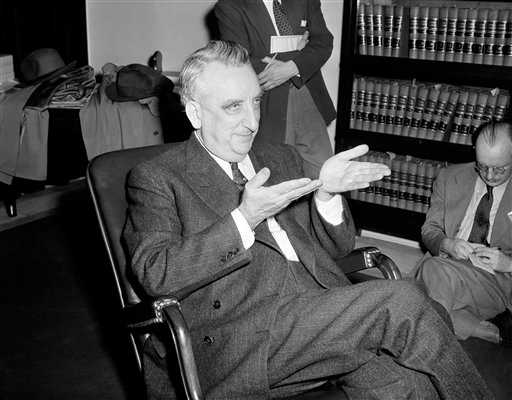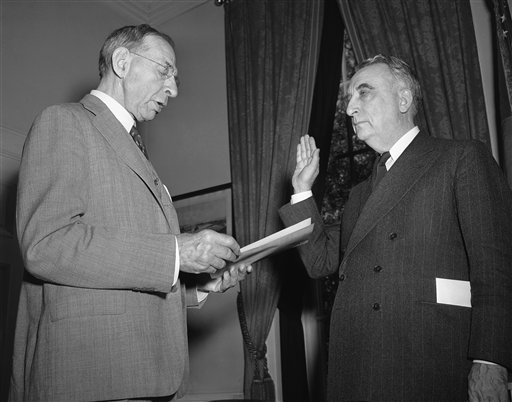Frederick Moore Vinson (1890–1953) was the 13th chief justice of the United States. The Cold War, fear of Communism, and government loyalty and security programs dominated the Court’s docket during Vinson’s tenure.
Vinson played a leading role in creating New Deal programs
Frederick Vinson was born in Louisa, Ky., on Jan. 22, 1890. He was elected to the U.S. House of Representatives as a Democrat in 1922, and while in Congress he befriended Missouri senator Harry S. Truman, who became his long-time friend.
While in Washington, Vinson played a leading role in creating New Deal programs. In 1938 President Franklin D. Roosevelt appointed Vinson to the District of Columbia Circuit Court of Appeals, and five years later appointed him to the first of several positions charged with managing the domestic wartime economy. In 1945 President Truman chose Vinson as his secretary of the treasury. When Chief Justice Harlan Fiske Stone died the following year, Truman appointed Vinson chief justice.
Court was contentious during Vinsons’s tenure
During his seven-year tenure, Vinson found it difficult to work with a contentious Court dominated by strong personalities, including Hugo L. Black, Felix Frankfurter, Robert H. Jackson, and William O. Douglas. Assigning himself only a few majority opinions in major cases, he allowed his brethren to define and lead the debate over the constitutional issues involving the Cold War, racial discrimination, the rights of organized labor, and the use of the 14th Amendment’s due-process clause to continue the nationalization of the Bill of Rights.
Vinson upheld national security over individual rights
In two major cases, Vinson upheld the government’s interest in protecting national security in spite of the individual rights at stake. Vinson’s opinion for the Court in American Communications Association v. Douds (1950) avoided the free-speech issue and upheld the constitutionality of Section 9 of the Taft-Hartley Act requiring labor union officers to sign affidavits attesting they were free of communist associations.
The next year, in Dennis v. United States (1951), he confronted the free-speech issue and affirmed the convictions of 11 Communist Party leaders for violating the Smith Act of 1940. In his opinion for the Court, he extended the clear and present danger test to reach conspiracy to advocate the violent overthrow of the government. This logic permitted the speech to be proscribed, no matter how remote the actual threat to incite unlawful action, when the gravity of the evil of such action was so great.

Fred M. Vinson during his time as associate justice of the District of Columbia Court of Appeals in 1943. During his tenure on the Supreme Court, Vinson was a moderate on race relations and found that racial segregation in legal education violated the equal-protection clause of the 14th Amendment (AP Photo/Robert Clover, used with permission from the Associated Press)
Vinson had a mixed First Amendment record
Vinson’s record was mixed when national security issues were not as prominent. In Feiner v. New York (1951), he wrote the majority opinion convicting a speaker who refused to stop giving a haranguing speech to a crowd when requested by the police to do so. However, Vinson also wrote the majority decision in Kunz v. New York (1951), deciding that a New York City statute requiring permits for religious services on public streets was not narrowly tailored and constituted an impermissible prior restraint.
Vinson’s dissent in Youngstown Sheet and Tube Co. v. Sawyer (1952) reflected his commitment to a strong federal government and a vigorous conception of the presidency. He rejected the majority’s view that President Truman’s seizure of the steel mills was an unconstitutional encroachment on the power of Congress to make law. The President’s seizure, he argued, was a legitimate exercise of his power as commander in chief and his duty to enforce congressional statutes authorizing seizure in order to avoid a strike that would have imperiled the production of military materiel for the Korean War.
Vinson wrote no major opinions reaching the merits of free exercise or establishment of religion claims. He joined the majority in the major decisions during his tenure that extended the establishment clause to the states (Everson v. Board of Education [1947]) and that upheld a public school release-time program that provided religious instructions for students off school premises (Zorach v. Clauson [1952]).

Fred M. Vinson, right, being sworn in as Economic Stabilization Director by Chief Justice Duncan Lawrence Groner of the U.S. Court of Appeals in 1943. Before becoming chief justice of the Supreme Court in 1946, Vinson served in several positions charged with managing the domestic wartime economy. As chief justice, Vinson presided over a contentious Court that had strong personalities and decided many cases relating to the First Amendment. (AP Photo/George R. Skadding, used with permission from the Associated Press)
Vinson was a moderate on race relations
The Vinson Court took decisive action against racial discrimination in housing, education, transportation, criminal justice, voting rights, and labor relations. A moderate on race relations, Vinson wrote unanimous opinions in two major cases.
In Shelley v. Kraemer (1948), he held that judicial enforcement of racially restrictive housing covenants violated the equal-protection clause. In Sweatt v. Painter (1950), Vinson acknowledged that two racially separate Texas law schools were not physically equal, but he declined to use the separate-but-equal doctrine established in Plessy v. Ferguson (1896). Instead, he crafted a new equal protection standard based on intangible criteria — “those qualities incapable of objective measurement” — and then used it to find that racial segregation in legal education violated the equal-protection clause of the 14th Amendment.
Later, the Court accepted five cases involving racial segregation in public elementary and secondary schools, but the cases were still undecided when Vinson died of a massive heart attack on Sept. 8, 1953.
This article was originally published in 2009. Dr. William C. Green (1954-2020) was a professor of political science and government at Morehead State University.

